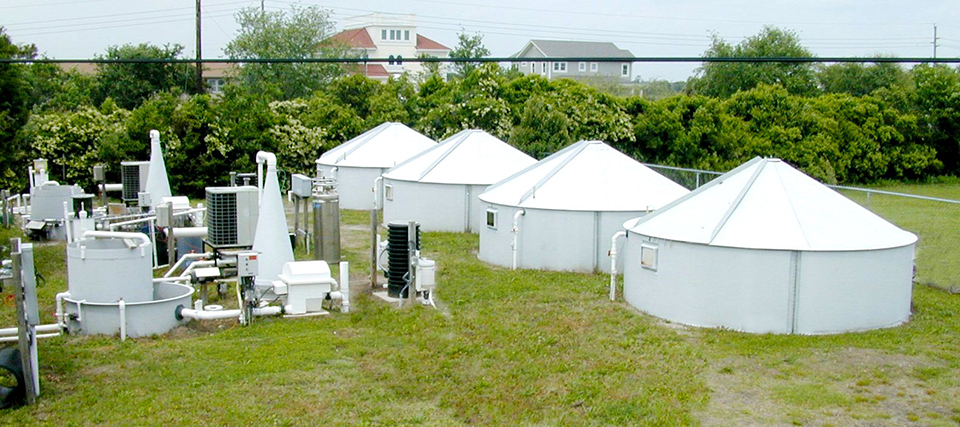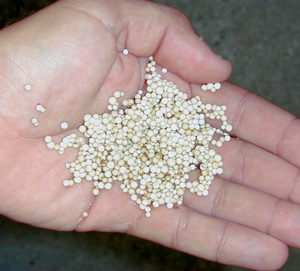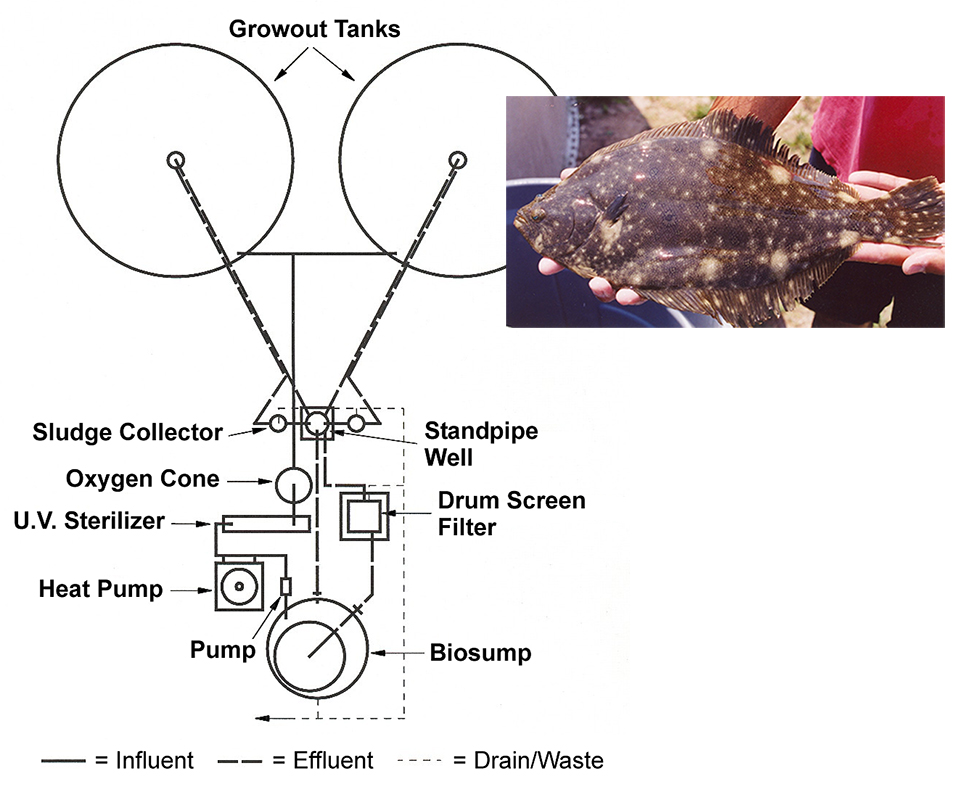Design tested over 700 days maintained acceptable TAN and nitrite levels

Recirculating aquaculture systems (RAS) are appropriate production systems for marine species because the high cost of coastal land can limit traditional, pond-based forms of production. The intensive nature of RAS allows for high production levels in small areas.
Although RAS have generated much interest in recent years, their main disadvantages are their high capital and operational costs. To offset these costs, efficient system designs are needed to produce high-value, high-demand species. One area to control expenses is the use of inexpensive polystyrene microbead filter media in biological filters for the systems.
Nitrification

Nitrification is the process that biologically converts ammonia to nitrite, and then relatively harmless nitrate. Biological filters contain media that harbors nitrifying bacteria to perform this task. The nitrification rate of these bacteria is inhibited by seawater due to its high chloride content, and free ammonia and nitrite ions.
Commercial biofilter media generally report nitrification rates for freshwater use. Because of the inhibitory effects of seawater on nitrification, biological filters may be undersized for use in marine RASes. Knowledge of the nitrification rate of a specific biological filter media and ammonia loading within a system are critical for the proper design and sizing of nitrifying filters used in RAS production systems.
Biofilter media
Commercially available biofilter media is generally costly. To help evaluate efficient system designs, the nitrification rate of an inexpensive polystyrene microbead filter media described by Greiner and Timmons in 1998 was examined in a near-commercial- scale marine RAS used for grow-out of summer flounders.
Polystyrene microbeads are small styrofoam beads with a mean diameter of 1-3 mm and estimated surface area of 1,145-3,936 square meters per cubic meter depending on bead diameter. In this study, the microbeads cost U.S. $9.30 per cubic meter, whereas an equivalent moving bed media would cost approximately U.S. $1,112 per cubic meter. The high surface area and low cost of this media make it a good candidate for biological filter media.
Experimental system
The authors recently conducted grow-out studies of summer flounder fingerlings at the University of North Carolina Wilmington Center for Marine Science in Wilmington, North Carolina, USA. The microbead biological filter was concurrently evaluated for use in marine recirculating systems. The system design was based on the North Carolina State University Fish Barn model (Fig. 1). The RAS consisted of two groups of tanks, each with two 11.3-cubic-meter circular fiberglass tanks of 4.6-meter diameter and 0.7-meter depth.
Each group was supported by an independent recirculating system. Each tank contained a center double drain fitted with an 11-l sludge collector. The effluent stream was treated with a rotating drum screen filter utilizing a 60-μ screen to remove fine solids. The filtered water was then distributed over the biological filter through a perforated distribution plate. The biological filter media consisted of 0.53 cubic meters of 3-mm polystyrene microbeads with an estimated specific surface area of 1,145 square meter per cubic meter.
Water pumped out of the biological filter passed through a 3-kW heat pump. Asmall portion of the flow was diverted to a foam fractionator that recycled water back into the biological filter. Water from the heat pump was treated by a 260-W ultraviolet sterilizer, then passed through a down-flow oxygenation cone before entering the culture tanks through inlet manifolds designed to aid in self-cleaning. Carbon dioxide stripping was accomplished by air diffusers placed at the bottom of the biological filter, and a forcedair degassing column between the water distribution plate and the biological filter media.

Grow-out trials
A total of 2,028 summer flounder fingerlings of about 85 grams were stocked into two 11.3-cubic-meter tanks and fed a 50 percent-protein, 12 percent-lipid floating flounder diet.
To test the nitrification rates of the microbead media in the marine microbead filter, total ammonia nitrogen (TAN) levels were measured from the influent and effluent biofilter water streams. Samples were gathered every two to four hours on four days during the 700-day growout experiment while fish were at different average weights. Volumetric nitrification rates (VNR) were calculated as:
VNR = (CTANin– CTANout) x flow rate per day) per volume of filter media
Where: VNR is expressed in g TAN removed per m3 media per day
CTANin is the concentration of TAN in the inflow to the filter in grams per liter.
CTANout is the concentration of TAN in the outflow of the filter in grams per liter.
During the study, salinity averaged 32.5 grams per liter, temperature averaged 21.6 degrees-C, and pH averaged 7.2. The mean hydraulic loading rate was 0.71 cubic meters per square meter per day (300 lpm).
Biofilter tests
Mean VNR was 137 grams per cubic meter per day at a mean TAN influent concentration of 0.37 milligram per liter. With a maximum influent TAN level of 0.73 milligrams per liter, the maximum recorded VNR was 269 grams per cubic meter per day. At the maximum TAN influent concentration, VNR was still rising steadily, showing that the media still had the capacity to remove more TAN. While influent TAN concentrations seemed low for a nitrification rate study, this was in an actual production system where higher TAN levels are not desirable. Maximum fish densities during the study reached 32 kilograms per cubic meter.
Conclusion
Polystyrene microbeads can be used as an effective marine biological filter media in recirculating aquaculture systems. The filter design as tested was able to maintain acceptable TAN and nitrite levels during a 700-day study. The extremely low cost of polystyrene microbeads should provide an incentive to perform more research for filter designs and more extensive nitrification studies.
Because the media is extremely small and lightweight, extra care is needed when designing the media’s housing. The beads can find their way out of any gap and into other parts of the system, where they can cause equipment to malfunction. Also, because it is a static bed, the media eventually begins to collect solids. Proper solids filtration must be placed before the biological filter, and an effective mechanical or hydraulic way to stir the bed should be employed.
(Editor’s Note: This article was originally published in the June 2003 print edition of the Global Aquaculture Advocate.)
Now that you've finished reading the article ...
… we hope you’ll consider supporting our mission to document the evolution of the global aquaculture industry and share our vast network of contributors’ expansive knowledge every week.
By becoming a Global Seafood Alliance member, you’re ensuring that all of the pre-competitive work we do through member benefits, resources and events can continue. Individual membership costs just $50 a year. GSA individual and corporate members receive complimentary access to a series of GOAL virtual events beginning in April. Join now.
Not a GSA member? Join us.
Authors
-
Patrick M. Carroll, M.S.
University of North Carolina
Wilmington Center for Marine Science
7205 Wrightsville Avenue
Wilmington, North Carolina 28403 USA -
Wade O. Watanabe, Ph.D.
University of North Carolina
Wilmington Center for Marine Science
7205 Wrightsville Avenue
Wilmington, North Carolina 28403 USA -

Thomas M. Losordo, Ph.D.
North Carolina State University
Raleigh, North Carolina, USA
Tagged With
Related Posts

Responsibility
A look at unit processes in RAS systems
The ability to maintain adequate oxygen levels can be a limiting factor in carrying capacities for RAS. The amount of oxygen required is largely dictated by the feed rate and length of time waste solids remain within the systems.

Responsibility
Automated temperature-controlled recirculation systems
A temperature-control system with a central chiller was found to enhance chilling and research capacity over a system with multiple unit chillers because replicating experiments in a single process control system minimized variations in the temperatures and chilling rates in the individual tanks. Temperature-holding experiments found slight differences at different temperature levels.

Health & Welfare
Biofilter inoculation in recirculating aquaculture systems
Biological filters are essential parts of recirculating aquaculture systems that transform toxic fish compounds such as ammonium and nitrite into less-harmful nitrate. The authors tested the convenience and efficiency of three methods for the initial inoculation of aerobic biofilters.

Responsibility
Microbead filters: cost-effective, scalable filtration
Microbead filters are an effective filtration solution that can be scaled to large production systems at a lower cost of operation than fluidized-sand bed filters.


